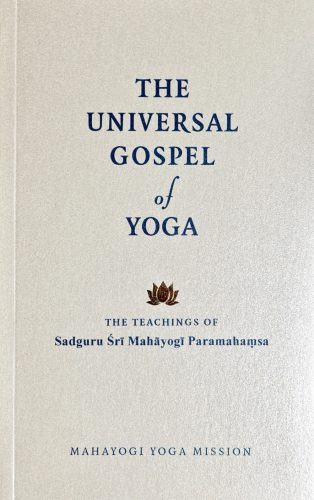Sunday February 27, 2022 NYC
Talk at the End of the Asana & Meditation Class
Friday, February 25, 2022:
I Began to Apply
“Make your body, words and intentions in daily life match.”
From the first time I read, “Make your thoughts, words and deeds always be as one,” in The Universal Gospel of Yoga, I thought of it as an unbelievably ambitious aim, and one that I would never be able to reach. “ How can my thoughts, words and deeds ever be aligned? That is impossible.” Although I took the words as accurate and true, my mind was automatically convinced that I would never be able to experience them in my own life.
How can my thoughts, words and deeds ever be aligned? That is impossible.” Although I took the words as accurate and true, my mind was automatically convinced that I would never be able to experience them in my own life.
Recently, I read that these same words were spoken by Gopala (a disciple and practitioner in Japan) during a special meditation course in September of 2020, in which he spoke about his actual practice and experience of meditation. What he spoke on that occasion is now published Pranavadipa (Vol. 87) under the title: “The Work of Constructing a Foundation for the Practice of Meditation.” When I read this title, I was instantly intrigued because for some good amount of time, I have been wanting to deepen my practice of meditation and have not found a way. I quickly told myself, “Pay attention and learn!”
In the course, Gopala had described the time when he had stayed at the Cave in New York City with Shri Mahayogi. Halfway into his stay, he asked Shri Mahayogi how to deepen his meditation. The answer was, “Make your body, words and intention in daily life match.” I immediately thought, “Oh! These words again! The unattainable words!” Not to my surprise, I wanted to dismiss them again, but when I read on, he further explained that “if these three do not match with one another, the mind cannot focus on one point during meditation.” And he further explained that the three must also be in accordance with the teachings of Yoga, rather than with our ego and desires.
I had to sit with and consider this for a moment because I had already concluded that I needed and wanted to deepen meditation in order to make progress in Yoga. This was clear, but what did not seem so clear was how to apply this challenging teaching. I made a little effort to place on hold the impulse to dismiss the words, but all I could do in lieu of that was to let the words live within me somewhere, sensing that I would need them at some point to help me get past my own ideas about what I can and cannot do—besides that, I just kept going about my daily routines.
It was a few days after reading the Testimony, while working as a teacher in my 5th grade classroom that I got the opportunity to try something. Being a primary school teacher can be quite the constant struggle: the students react in all kinds of ways, and it feels so effortful to get them to learn or do anything! On this day, however, as I observed my mind during our interactions, I reached the conclusion that the most challenging aspect of my job was not the way the students react, but rather my own thoughts around those reactions, and around the struggles of getting them to do what I want them to do.
However, on that same day something began to open up; it wasn’t the literal words of the teaching, “Make your thoughts, words and deeds always be as one.” What was new was an intensified need to act upon these words and to know their meaning through action. At last, during one of those typical moments of tension with my students, I was able to “watch” my own internal reaction before it manifested outwardly as words and actions. In that split second between thinking and doing, I was able to ask myself, what is the intention right now behind these thoughts and words that are arising? These types of interactions felt like an uphill battle, so unpleasant and burdensome, so I already knew that something was not aligning with the Truth in my way of functioning. The result was always a lack of harmony, of lovingness and of tranquility—as if a dark shadow was hanging over me and over them too.
The only idea that I came up with in order to attempt to change the outcome was to try looking at it from my students’ point of view as soon as it began to happen. I was surprised to learn that it was possible to do this quite fast! As soon as a situation started, I asked myself “What do they hear, feel, see from me towards them right now? And…what is it that they really need from me?” The answer came quickly too: “what they need the most is to feel that I genuinely care about them.” I could admit that many times, they must have felt that I did not care for them so much, and perhaps they were right in thinking that. So then, “what is it that I care for the most?” My conclusion was that, based on my thoughts, words and deeds toward them, what I cared the most was to be perceived as the one who knows. In other words, wanting to show “I know” was a stronger of an intention than to show “I care.” And I could see that this intention was clearly not aligned with Yoga because through Yoga I have learned that all God’s creatures are precious and valuable in this world, they are God itself, all of us!
Desperate to try to switch this around, I quickly tried controlling my own impulse to come off as if “I know,” and instead try to nourish the intention to care for the student in front of me, and for all of them at the same time too. In other words, I decided to try to use each interaction for working toward bringing the intention of “caring” authentically into my thoughts, my words, my tone of voice, my movements and choices.
Yesterday, a student screamed from his desk with great angst, “I did not bring my homework today!” Instinctively, I wanted to scream back at him and chastise him for that. Well…in reality, I started to, but then I remembered that I was working on being one with my intention of caring, I asked him to come sit next to me. I made myself look him in the eyes gently, lower my tone, put a check on my intensity, slow down…and ask him with tenderness in my heart, “What happened Michael? My Miguelito, I know you are very responsible, so you must not have left your homework on purpose.” He explained his situation in simple words, with a good degree of hesitation. I could feel his little heart beating in my own chest. What was most amazing to me was that he was also looking at me straight into my eyes with deep tenderness, making me feel that we were both caring for each other above and beyond the circumstances. It was as if I was looking at myself through his eyes. At that instant, I noticed that the high degree of tension that typically arises in me during these moments had drastically subsided! Finally, I was at ease with him and him with me.
I am eager to continue checking my intentions by asking, “Am I caring for this precious person in front of me or am I seeking for them to think that ‘I know?’” Every time I have asked myself this question, the automatic result has been an immediate change in my attitude, and an opening up to the person in front of me, which allows me to feel that I care for them, and to my surprise, to feel cared for by them too!
Today, I can say that through these small efforts and simple experiences, I have gained hope in the path toward learning how to “make your thoughts, words and deeds always be as one,” something that I had deemed impossible for so many years. Thank you so much, Gopala, my gurubai, on the other side of the earth, for the motivation to try to use Shri Mahayogi’s words in my life for the first time.
~ Karuna
To make a financial contribution, visit our CONTRIBUTION PAGE.
Visit and share our WELCOME PAGE to join our online classes.
